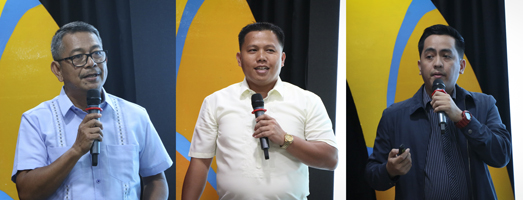 Finalists of the National Symposium for Agriculture, Aquatic and Natural Resources Research and Development (NSAARRD) presented their respective entries in hopes of winning the Best Research and Development (R&D) Paper.
Finalists of the National Symposium for Agriculture, Aquatic and Natural Resources Research and Development (NSAARRD) presented their respective entries in hopes of winning the Best Research and Development (R&D) Paper.
The NSAARRD was held on April 29, 2019 at the Philippine Council for Agriculture, Aquatic and Natural Resources Research and Development of the Department of Science and Technology (DOST-PCAARRD) Innovation and Technology Center (DPITC).
Six finalists for both Research and Development Categories vied for the 1st, 2nd, and 3rd places, with the winning entries to be announced and awarded on June 19, 2019 at the Philippine International Convention Center (PICC), Pasay City in time for the Council’s 8th anniversary celebration.
Under the research category are “Enhancing Milk Production of Dairy Goats through Indigofera zollingeriana Supplementation” of the Central Luzon State University (CLSU); “Innovation of Root Trainer Technique and Precision Grafting Technology for Rapid Propagation of Quality Planting Materials of Rubber” of the Department of Agriculture-Regional Field Office 9 (DA-RFO 9); and “Spore Bank Establishment, Propagation, and Conservation” of the Central Mindanao University (CMU).
The CLSU study aims to address dairy goat’s feed availability through its Indigofera-based pellets, which they coined “Sure Feed for Goats” or “SFEED.” On the other hand, the DA-RFO 9 study seeks to provide quality planting materials of rubber using the root trainer technology. The technology speeds up the growth of seedlings in 5-6 months compared with the conventional method of sowing one whorl of rubber seeds in budded polybags, which takes 8-10 months. Lastly, the CMU technology aims to address the decline of ferns biodiversity in the country by populating the spore bank in the university. The spore bank already contains 770 collections of spores from 120 species of ferns.
 On the other hand, entries vying for the top place in the development category are “CPAR on Integrated rice-based farming system management: Approach towards Community-driven Agricultural Development in Ilocos Norte” of the DA-RFO 1; “Technology Demonstration and Promotion of Mechanized Rice Farming in the Lowland Irrigated Areas in Region 2” by DA-RFO 2; and “Enhancing Mungbean Production in Bicol Region” of the DA-RFO 5.
On the other hand, entries vying for the top place in the development category are “CPAR on Integrated rice-based farming system management: Approach towards Community-driven Agricultural Development in Ilocos Norte” of the DA-RFO 1; “Technology Demonstration and Promotion of Mechanized Rice Farming in the Lowland Irrigated Areas in Region 2” by DA-RFO 2; and “Enhancing Mungbean Production in Bicol Region” of the DA-RFO 5.
The DA-RFO 1 study details the results of its Community-based Participatory Action Research (CPAR), wherein farmers benefitted from an increased cropping pattern from 20 hectares (ha) to 60.4 ha and a high net return amounting to ₱33,727.91/ha (444.51% increase) in rainfed areas and ₱66,394.07/ha (164% increase) in irrigated areas. Meanwhile, the DA-RFO 2 study aims to increase the level of rice production through the use of machines such as the Mechanical Direct Seeder and Transplanter. Lastly, the DA-RFO 5 study employs the strategy of crop diversification to maximize land use and increase income and productivity.
Organized by DOST-PCAARRD, the NSAARRD recognizes the outstanding contributions of individuals and institutions in improving the state of R&D in the country for the interest of the agriculture, aquatic and natural resources sector.
